State Model Legislation
For states wishing to introduce legislation that establishes retirement savings programs for private sector workers, examples of model legislation are available.
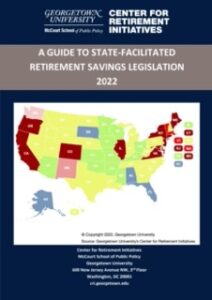 A Guide to State-Facilitated Retirement Savings Legislation, 2022 – Supporter Access Only. This guide documents the legislation enacted or introduced in state and cities in 2022, organized by type of model considered. During the 2022 legislative session, at least 17 states and cities introduced or enacted program or study legislation. Since 2012, more than 46 states have considered or enacted legislation to address the retirement savings gap among private-sector workers.
A Guide to State-Facilitated Retirement Savings Legislation, 2022 – Supporter Access Only. This guide documents the legislation enacted or introduced in state and cities in 2022, organized by type of model considered. During the 2022 legislative session, at least 17 states and cities introduced or enacted program or study legislation. Since 2012, more than 46 states have considered or enacted legislation to address the retirement savings gap among private-sector workers.
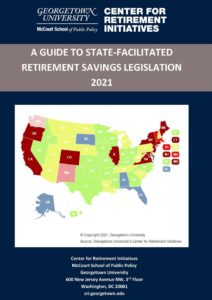 A Guide to State-Facilitated Retirement Savings Legislation, 2021 – Supporter Access Only. This guide documents the legislation enacted or introduced in state and cities in 2021, organized by type of model considered. During the 2021 legislative session, at least 22 states and cities introduced or enacted program or study legislation. Since 2012, more than 46 states have considered or enacted legislation to address the retirement savings gap among private-sector workers.
A Guide to State-Facilitated Retirement Savings Legislation, 2021 – Supporter Access Only. This guide documents the legislation enacted or introduced in state and cities in 2021, organized by type of model considered. During the 2021 legislative session, at least 22 states and cities introduced or enacted program or study legislation. Since 2012, more than 46 states have considered or enacted legislation to address the retirement savings gap among private-sector workers.
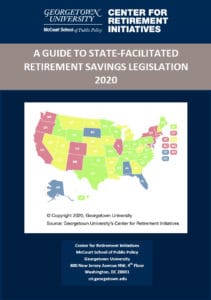 A Guide to State-Facilitated Retirement Savings Legislation, 2020 – Supporter Access Only. This guide documents the legislation enacted or introduced in state and cities in 2020, organized by type of model considered. During the 2020 legislative session, at least 20 states and cities introduced or enacted program or study legislation. Since 2012, more than 45 states have considered or enacted legislation to address the retirement savings gap among private-sector workers.
A Guide to State-Facilitated Retirement Savings Legislation, 2020 – Supporter Access Only. This guide documents the legislation enacted or introduced in state and cities in 2020, organized by type of model considered. During the 2020 legislative session, at least 20 states and cities introduced or enacted program or study legislation. Since 2012, more than 45 states have considered or enacted legislation to address the retirement savings gap among private-sector workers.
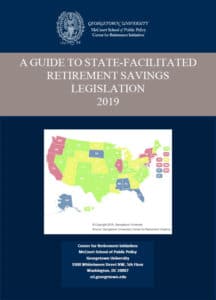 A Guide to State-Facilitated Retirement Savings Legislation, 2019 – Supporter Access Only. This guide documents the legislation enacted or introduced in state and cities in 2019, organized by type of model considered. During the 2019 legislative session, at least 23 states and cities introduced or enacted program or study legislation. Since 2012, more than 45 states have considered or enacted legislation to address the retirement savings gap among private-sector workers.
A Guide to State-Facilitated Retirement Savings Legislation, 2019 – Supporter Access Only. This guide documents the legislation enacted or introduced in state and cities in 2019, organized by type of model considered. During the 2019 legislative session, at least 23 states and cities introduced or enacted program or study legislation. Since 2012, more than 45 states have considered or enacted legislation to address the retirement savings gap among private-sector workers.
 A Guide to State-Facilitated Retirement Savings Legislation, 2018 – Supporter Access Only. This guide documents the legislation enacted or introduced in state and cities during 2018, organized by type of model considered. During the 2018 legislative session, at least 16 states and cities introduced or enacted legislation. Since 2012, more than 43 states have considered or enacted legislation to address the retirement savings gap among private-sector workers.
A Guide to State-Facilitated Retirement Savings Legislation, 2018 – Supporter Access Only. This guide documents the legislation enacted or introduced in state and cities during 2018, organized by type of model considered. During the 2018 legislative session, at least 16 states and cities introduced or enacted legislation. Since 2012, more than 43 states have considered or enacted legislation to address the retirement savings gap among private-sector workers.
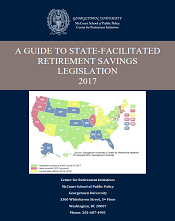 A Guide to State-Facilitated Retirement Savings Legislation, 2017 – Supporter Access Only. This guide documents the legislation enacted or introduced in state and cities during 2017, organized by type of model considered. During the 2017 legislative session, at least 22 states and cities introduced or enacted legislation. Since 2012, more than 40 states have considered or enacted legislation to address the retirement savings gap among private-sector workers.
A Guide to State-Facilitated Retirement Savings Legislation, 2017 – Supporter Access Only. This guide documents the legislation enacted or introduced in state and cities during 2017, organized by type of model considered. During the 2017 legislative session, at least 22 states and cities introduced or enacted legislation. Since 2012, more than 40 states have considered or enacted legislation to address the retirement savings gap among private-sector workers.
State Auto-IRA (“Secure Choice”) Program
Morse, David E. (Spring 2019). Helping the Other Half Save: Model State Auto-IRA Act. Benefits Law Journal, 32(1), offers model legislation for states that have yet to pass Auto-IRA secure choice savings programs.
Secure Choice 2.0: States Blazing a Path to Retirement Security for All, by the National Conference on Public Employee Retirement Systems (NCPERS), offers model legislation for an auto-IRA program (see Appendix 2).
State Multiple Employer Plan (MEP)
Multiple Employer Plans (MEPs) – An Overview of Legal, Regulatory and Plan Design Considerations for States, by the Georgetown University Center for Retirement Initiatives (CRI), offers model legislation for a MEP program (see Appendix B).
Secure Choice Pension
The Secure Choice Pension: A Way Forward for Retirement Security in the Private Sector
Introduced by NCPERS in September 2011, the Secure Pension Plan (SCP) is designed as a public-private enterprise for private-sector workers currently without a pension and is not intended to replace existing pension plans. It will work in conjunction with Social Security and personal savings to help close the retirement savings gap. ERISA and other federal laws would be amended to permit any state to establish a plan through enabling legislation. Individual states or groups of states would enact legislation to establish state or regional-based SCP plans. Each SCP would be a multiple-employer defined benefit plan based on the cash balance model with the following design elements:
- The actuarial risks of plan funding would be spread across participants.
- SCPs would be subject to the ERISA minimum funding requirements and would utilize ERISA funding rules that currently apply to private-sector multi-employer plans.
- Adjust benefit accruals for changing economic conditions.
- Provide options to serve as a backstop for underfunding.
- Allow participants a guaranteed minimum retirement income through a default life annuity benefit, with an opportunity for additional earnings through period dividends if the SCP’s actuary has certified that such dividends would not materially impair the full funding of the retirement fund.
